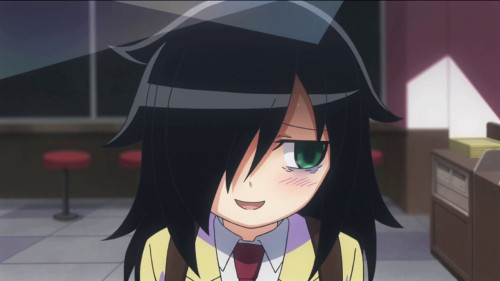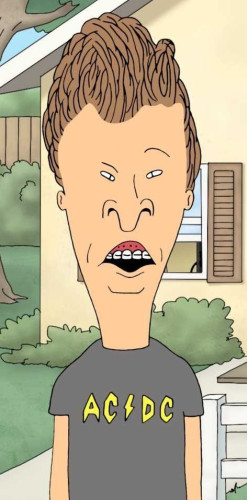In this month’s Genshiken the guys and girls are separated on the line to Comic Festival, but in both cases the topic is the same: Madarame, and the women (and man) who might love him. There’s also some cosplay, as the girls dress up as the cast from Bodacious Space Pirates.
![]() Yajima as Luca, Yoshitake as Coorie
Yajima as Luca, Yoshitake as Coorie
The real-life Comic Market upon which Genshiken‘s Comic Festival is based is traditionally seen as a space existing in a dimension separate from the realm of romance and general extroverted interaction. It’s a distinction acknowledged even by Genshiken itself (Madarame’s famous exclamation that having a tan at ComiFes is “embarrassing), but it’s also a series where relations are fostered (Sasahara and Ogiue). Even though the series does have a tendency to place those conventionally incongruous elements together, the juxtaposition between people discussing potential love interests while waiting hours to buy doujinshi is nevertheless still quite strong.
The boys’ discussion revolves around the four whom Kasukabe believes have something for Madarame, namely Angela, Sue, Keiko, and Hato. Although Kasukabe is the definitely the most socially perceptive character in the series she’s also not perfect (she thought Madarame fell in love with her well before he actually did), so it isn’t necessarily presented as the gospel truth aside from the extremely obvious Angela. Given her strong observational skills, however, it’d still be fun to discuss each of them in detail, not to pick the “best” one but to do some semi-intense character analysis.
Before we get into it, though, I do want to say that it isn’t that unusual for Madarame to be a target of affection, and I don’t mean that in a “deep down he’s a good guy” sort of way. Not only is Madarame kind and intelligent, but he’s made major strides of the years to improve his sociability. That, and some girls are into the scrawny nerd type.
![]() Angela,dressed as Misa Grandwood, Ohno in the background as Chiaki Kurihara
Angela,dressed as Misa Grandwood, Ohno in the background as Chiaki Kurihara
If you’ll recall, Angela’s interest in Madarame is actually a retcon from the second TV series (Genshiken 2, not be confused with Genshiken Second Season even though it’s totally easy to do so). The aggressive Angela enjoys Madarame’s passive demeanor, and what’s especially important about her perspective is that she isn’t thinking of this in a very romantic sort of way. While she wouldn’t mind seeing him long-term, she’s also definitely okay with a down and dirty one night stand. One thing I find interesting about Angela is that in her you have the portrayal of a woman who’s using every asset at her disposal to (literally) charm the pants off a guy. Even putting aside the aggression, if you look again at Chapter 66, you’ll notice that at the end of the day Angela switches from the outfit she was wearing in the morning to one with a short skirt and exposed cleavage.
Angela’s original appearance in the manga involves her, a non-Japanese speaking foreigner with a perfect body being very social, a form of kryptonite to the poor otaku Madarame. Personally speaking, there’s something hilarious about a rigid guy being with a sexually charged bombshell in that it’s fun to watch the layers of restraint and fear either melt away or intensify. For Madarame it’s more the latter, a response I find to be realistic for a nerd, though the fact that the unrequited love for Kasukabe is now a done deal changes the game. Her attitude frequently makes me wonder about what life is like for her most of the year, especially because she’s such a fearsome individual, able to notice Madarame’s pining for Kasukabe after just one or two brief ComiFes visits.
![]() Sue as Gruier Serenity
Sue as Gruier Serenity
While I’ve seen some Angelas in the American anime fandom, I’ve seen many more Sues, and I still find her to be surprisingly close to the kind of fans I tend to encounter at US anime conventions (although Yoshitake is actually pretty close too). Sue appears shortly after Angela in the original series delivering Asuka’s signature insult (“Anta baka?”), and it’s been interesting seeing her develop, from a non-sequitur gag machine with a penchant for making things awkward for those around her, to a fully fleshed-out character fluent in Japanese though still capable of intentionally generating the same awkwardness.
Sue’s feelings for Madarame aren’t as clear-cut as Angela’s, but Sue also frequently interacts with Madarame while appearing to enjoy it immensely. If she does like Madarame to that extent, it explains a lot of her actions with respect to him, like her remark that Madarame should “find a new love.” I also have to wonder how an actual relationship between the two would look. Sue is perhaps the only girl that can go toe-to-toe with Madarame when it comes to sheer obsession with anime and manga to the point of building up a seemingly endless wealth of quotes. There’s also something about their combined awkwardness that makes me imagine some of the interactions from Nichijou.
![]()
The thing I find funniest about Keiko is that years ago, when the original manga was still running in Japan, before there were these specific moments in Nidaime between the two to fuel the fire, there were already fans of the Madarame x Keiko pairing. If I had to reason why the combination has its supporters, it could be that in a way this would be the most “realistic” (read: cynical) couple, that image of the otaku whose average-looking girlfriend doesn’t quite understand his hobby and is a little too frivolous with cash. Perhaps the best reason is that Madarame was rejected by Kasukabe while Keiko’s affections for Kohsaka never went anywhere, comfort in mutual sorrow. Still, the reaction from Madarame and Sasahara is understandable (and also hilarious), as Sasahara basically pleads with Kohsaka and Hato to strike the very idea from the world. Watching the two guys basically not even consider her a factor is one of the best parts of the chapter.
The extras in Volumes 13 and 14 of Genshiken paint an interesting picture of Keiko. In Volume 14, Hato notices that Keiko has actually changed her makeup style to a more natural-looking one. One of Keiko’s visual characteristics since her debut in the manga has been her heavy makeup, and to forego it in favor of a lighter look implies that she’s aiming for a guy who might find that heavily dolled up look intimidating. On the other hand, a Volume 13 extra also shows that she has some interest in Hato, asking him if he’d be willing to have sex with a girl while still in drag. That 4-panel comic actually changed my perception of Keiko, and I wonder if her position in all of this is more complex than first expected.
![]()
Then there’s Hato, whose interactions with Madarame I’ve analyzed many times over and which you’ll find in numerous previous chapter reviews. Two things are clear: Hato is really complicated, and he pays a lot of attention to both Madarame and the people around Madarame. After all, he’s the one who noticed that Keiko changed her makeup. He’s also clearly very confused about what he does and doesn’t want, and you can see it in the way he went from needing to crossdress no matter what, to absolutely refusing to do so and trying to play the part of Average Joe Otaku. It sort of reminds me of when nerds who know nothing about sports (which includes myself to an extent!) try to discuss basketball or something: awkward, unfamiliar, clearly an act.
His past with Kaminaga makes it even more difficult to discern his intentions, as it isn’t clear whether he wanted her or wanted to be with her (or perhaps even both). However, if we assume that Hato does have feelings for Madarame, he then presents an interesting position in that he would see himself as a man who likes to crossdress and look at yaoi, but not someone who identifies as a woman and would therefore see a relationship with a man as heterosexual. If Genshiken then actually had him get together with Madarame, it would bring the entire manga to a whole other place.
The chapter ends with Yajima getting ready to say something to Hato, and amidst this strange situation their relationship is also something which has changed over time. Where once Yajima had been uncomfortable with Hato in drag, now she’s the opposite, mirroring Hato’s own feelings. I’m actually quite looking forward to how this develops next month. The “next chapter” reference, by the way, is Jewelpet Happiness.
One last vitally important thing to discuss: Ogiue’s cosplay is amazing. Somehow the series keeps finding great characters for her to dress up as, and even if the look doesn’t match entirely her intense expression makes it entertaining nonetheless. Ogiue cosplay is something special.
![]() Ogiue as Quartz Christie
Ogiue as Quartz Christie
![]()
![]()


















































 Yajima as Luca, Yoshitake as Coorie
Yajima as Luca, Yoshitake as Coorie Angela,dressed as Misa Grandwood, Ohno in the background as Chiaki Kurihara
Angela,dressed as Misa Grandwood, Ohno in the background as Chiaki Kurihara Sue as Gruier Serenity
Sue as Gruier Serenity

 Ogiue as Quartz Christie
Ogiue as Quartz Christie











































